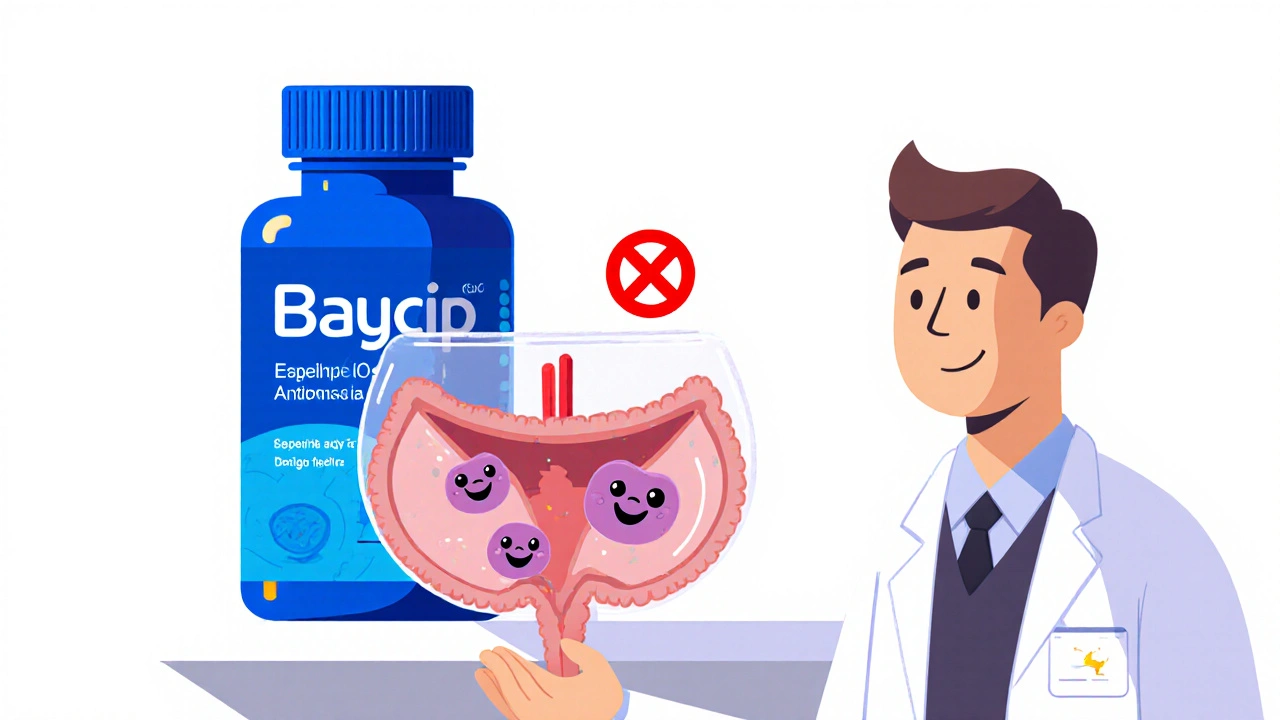Antibiotic Selection Guide
Choose Your Scenario
Key Takeaways
- Baycip is a brand‑name ciprofloxacin tablet commonly used for urinary and respiratory infections in Australia.
- Resistance, side‑effect profile, and cost often push clinicians toward alternatives like levofloxacin, moxifloxacin, azithromycin, doxycycline or amoxicillin.
- Each alternative has a distinct spectrum, dosing regimen, and safety considerations - no single drug fits every case.
- Guidelines from the Australian Therapeutic Guidelines and the WHO recommend tailoring the choice to the infection site, pathogen susceptibility and patient factors.
- When switching from Baycip, always verify drug interactions, renal function, and local resistance patterns.
Understanding Baycip and Ciprofloxacin
When doctors need a broad‑spectrum antibiotic, many turn to Baycip a commercial formulation of the fluoroquinolone ciprofloxacin. It comes in 250 mg and 500 mg tablets and is approved by the Therapeutic Goods Administration (TGA) for treating uncomplicated urinary‑tract infections (UTIs), acute exacerbations of chronic bronchitis, and certain skin infections.
Ciprofloxacin is a synthetic fluoroquinolone that inhibits bacterial DNA gyrase and topoisomerase IV, halting DNA replication. Its broad activity covers many Gram‑negative organisms like Escherichia coli, Klebsiella pneumoniae, and Pseudomonas aeruginosa, plus some Gram‑positive bugs such as Staphylococcus aureus (excluding MRSA). The drug is excreted mainly unchanged in urine, which explains its high efficacy for UTIs.
Despite its usefulness, ciprofloxacin carries warnings for tendon rupture, QT‑interval prolongation, and potential central‑nervous‑system effects. These safety signals have led clinicians to consider alternatives, especially for patients with comorbidities or when local resistance exceeds 10%.
Why Look for Alternatives?
Three main forces push practitioners away from Baycip:
- Antimicrobial resistance. Australian surveillance data from 2024 show ciprofloxacin resistance rates of 12 % in community‑acquired UTIs and 18 % in respiratory isolates.
- Adverse‑effect profile. Tendonitis, photosensitivity, and drug‑drug interactions (e.g., with warfarin) are more common in older adults.
- Cost and accessibility. While Baycip is subsidised under the PBS, the out‑of‑pocket price can still be higher than generic alternatives like amoxicillin or doxycycline for some patients.
Guidelines therefore suggest reserving fluoroquinolones for cases where first‑line agents fail or when the pathogen is known to be susceptible.
Major Alternatives Overview
Below is a quick snapshot of five commonly considered substitutes. Each entry includes a brief definition, typical use cases, and key safety notes.
- Levofloxacin another fluoroquinolone with once‑daily dosing. Effective for community‑acquired pneumonia and complicated UTIs; shares many of ciprofloxacin’s risks but offers better lung penetration.
- Moxifloxacin a later‑generation fluoroquinolone with enhanced activity against anaerobes. Preferred for chronic obstructive pulmonary disease (COPD) exacerbations; still carries tendon‑rupture warnings.
- Azithromycin a macrolide that concentrates in macrophages and airway tissues. Used for atypical pneumonia, chlamydia, and certain skin infections; cardiotoxicity (QT prolongation) is its main concern.
- Doxycycline a tetracycline that inhibits bacterial protein synthesis. Good for acne, Lyme disease, and some sexually transmitted infections; causes photosensitivity and esophageal irritation.
- Amoxicillin a broad‑spectrum penicillin often combined with clavulanic acid. First‑line for many ear, nose, throat infections and uncomplicated UTIs; ineffective against many resistant Gram‑negatives.
Side‑by‑Side Comparison
| Drug | Spectrum | Typical Dose (Adult) | Common Side Effects | Australian PBS Cost (AU$) |
|---|---|---|---|---|
| Baycip (Ciprofloxacin) | Gram‑negative + some Gram‑positive | 500 mg PO BID 3‑7 days | Tendon pain, nausea, photosensitivity | ≈ $22 (PBS‑eligible) |
| Levofloxacin | Similar to ciprofloxacin, better lung coverage | 500 mg PO daily 5‑7 days | Headache, QT prolongation, tendon risk | ≈ $30 |
| Moxifloxacin | Broad, includes anaerobes | 400 mg PO daily 5 days | Diarrhea, dizziness, QT prolongation | ≈ $38 |
| Azithromycin | Gram‑positive + atypicals | 500 mg PO day 1, then 250 mg daily 4 days | GI upset, liver enzyme rise, QT prolongation | ≈ $18 |
| Doxycycline | Broad, good for intracellular bugs | 100 mg PO BID 7‑14 days | Photosensitivity, esophageal irritation | ≈ $12 |
| Amoxicillin | Gram‑positive + some Gram‑negative | 500 mg PO TID 5‑7 days | Rash, diarrhea, rare hepatotoxicity | ≈ $8 |

How to Choose the Right Antibiotic
Picking an alternative isn’t a guess‑work exercise. Follow this decision pathway:
- Identify the infection site. Lung infections favour levofloxacin or azithromycin; skin and soft‑tissue infections often respond to doxycycline or amoxicillin.
- Check local resistance data. The Australian Antimicrobial Resistance Surveillance Program (ARSP) publishes quarterly reports; if ciprofloxacin resistance exceeds 10 % for the suspected pathogen, move to another class.
- Assess patient risk factors. Elderly patients, those on anticoagulants, or people with a history of tendon injury should avoid fluoroquinolones.
- Consider drug‑interaction profile. For example, azithromycin should be avoided in patients taking certain antiarrhythmics.
- Factor in cost and adherence. Once‑daily regimens (e.g., levofloxacin) improve compliance compared with multiple daily doses.
Using this framework helps you stay within the Therapeutic Guidelines: Antibiotic recommendations while minimizing adverse events.
Potential Pitfalls and Safety Tips
- Never prescribe fluoroquinolones for viral infections - they won’t work and will fuel resistance.
- If a patient reports tendon pain while on Baycip, stop the drug immediately and switch to a non‑fluoroquinolone.
- Screen for renal impairment: ciprofloxacin dosage needs reduction when creatinine clearance < 30 mL/min.
- Advise patients to stay hydrated and avoid excessive sunlight when taking doxycycline or ciprofloxacin.
- Document the indication in the medical record - this is essential for antimicrobial stewardship audits.
Frequently Asked Questions
Can I use Baycip for a simple sore throat?
No. Most sore throats are viral, and antibiotics won’t help. If a bacterial cause like streptococcus is confirmed, a narrow‑spectrum penicillin such as amoxicillin is preferred over Baycip.
What makes levofloxacin a better choice for pneumonia?
Levofloxacin achieves higher lung tissue concentrations and covers atypical organisms like Mycoplasma pneumoniae. That’s why guidelines list it as a first‑line oral option for community‑acquired pneumonia when penicillins fail.
Is there a risk of cross‑resistance between ciprofloxacin and other fluoroquinolones?
Yes. Bacteria that develop resistance mechanisms (e.g., gyrA mutations) typically become resistant to the whole fluoroquinolone class, so switching to levofloxacin or moxifloxacin won’t overcome the problem.
How does the cost of Baycip compare to generic amoxicillin?
Baycip costs about AU$22 under the PBS, while a standard 500 mg amoxicillin pack is roughly AU$8. For infections where amoxicillin works, it’s the cheaper and safer option.
Are there any patient groups that should never receive ciprofloxacin?
Pregnant women, children under 18 (except for specific indications), and patients with a history of tendon rupture should avoid ciprofloxacin unless no alternative exists.
By weighing infection type, resistance trends, and individual risk factors, you can decide whether Baycip remains the best choice or if one of the alternatives listed above fits better. Remember, the goal is effective cure with minimal collateral damage.






Rachael Turner
22 October, 2025 . 18:08 PM
I often think about how a drug’s journey from lab bench to pharmacy shelf mirrors a patient’s own journey through illness. Baycip’s broad spectrum makes it a useful tool but also a double‑edged sword. When resistance creeps up it feels like the walls are closing in on both prescriber and patient. It’s worth pausing to consider the ecological impact of each prescription, not just the immediate cure.
Iris Joy
22 October, 2025 . 20:54 PM
Great rundown! For clinicians juggling cost and safety, focusing on the patient’s comorbidities can really guide the choice. If someone’s on anticoagulants, steering clear of ciprofloxacin’s interaction with warfarin is wise. Likewise, checking local resistance data before reaching for a fluoroquinolone can save a lot of hassle down the line.
John Connolly
22 October, 2025 . 23:41 PM
From a prescribing standpoint, the decision matrix is fairly straightforward. Identify the infection site first, then cross‑reference the latest ARSP surveillance figures. If the pathogen’s susceptibility to ciprofloxacin falls below the 90 % threshold, pivot to an alternative class. Levofloxacin serves well for pneumonia due to its superior pulmonary penetration. For uncomplicated UTIs where E. coli remains sensitive, Baycip can still be cost‑effective under PBS.
Joe Waldron
23 October, 2025 . 02:28 AM
When looking at the safety profile, it’s hard not to notice the tendon‑related warnings, the photosensitivity concerns, the QT‑prolongation risk, especially in older patients, the drug‑drug interaction potential, the renal dosing adjustments needed, the gastrointestinal upset that many report, and the occasional central nervous system effects that can be quite unsettling.
Harini Prakash
23 October, 2025 . 05:14 AM
Hey folks 😊, just wanted to add that patient education is a key piece of the puzzle. Remind them to stay hydrated when on ciprofloxacin and to avoid intense sun exposure if they’re on doxycycline. Also, a quick chat about the signs of tendon pain can prevent a serious injury down the road.
Don Goodman-Wilson
23 October, 2025 . 08:01 AM
Oh great, another fluoro‑quinolone debate, just what we needed.
Bret Toadabush
23 October, 2025 . 10:48 AM
Honestly, they’re pushing these drugs to keep the pharma giants rolling, while the rest of us deal with side‑effects. Don’t be fooled by the fancy tables-they’re just masks for the real agenda.
Diane Thurman
23 October, 2025 . 13:34 PM
Look, the data’s clear: if you ignore resistance trends you’re basically inviting treatment failure. It’s not rocket science, just good practice.
Christa Wilson
23 October, 2025 . 16:21 PM
Super helpful summary! 🌟 It’s reassuring to see cost comparisons side by side with safety notes. Makes the decision a lot less intimidating for both docs and patients.
Emma Parker
23 October, 2025 . 19:08 PM
Totally agree, the cost factor can tip the scales, especially for younger folks on a tight budget. Just don’t forget to double‑check the PBS eligibility before writing it down.
Benedict Posadas
23 October, 2025 . 21:54 PM
Let’s keep the conversation moving forward-if you’ve successfully switched a patient from Baycip to amoxicillin, share the outcome! 😊 It helps us all see real‑world results beyond the tables.
Sameer Khan
24 October, 2025 . 00:41 AM
From a pharmacological stewardship perspective, the selection of an antimicrobial agent should be predicated upon a triangulation of three principal vectors: the pharmacokinetic/pharmacodynamic (PK/PD) parameters of the agent, the epidemiological susceptibility profile of the offending organism, and the host’s physiological reserve. In the case of ciprofloxacin, its concentration‑dependent killing is best harnessed via high‑dose, short‑duration regimens that achieve a peak‑to‑MIC ratio exceeding 10, a metric that is undermined when resistance mechanisms such as gyrA mutations or efflux pump overexpression are present. Empirical deployment of Baycip in a milieu where local resistance exceeds the 10 % threshold therefore contravenes the principle of optimal exposure, precipitating sub‑therapeutic drug levels and fostering selection pressure. Moreover, the propensity for fluoroquinolones to induce tendonopathy is mediated through matrix metalloproteinase activation, a pathophysiological cascade that is amplified in the elderly and in patients on concomitant corticosteroids. The QT‑prolongation risk, while comparatively modest, becomes clinically salient in individuals with baseline cardiac repolarization abnormalities or those receiving other QT‑affecting agents such as macrolides or antipsychotics. Renal clearance of ciprofloxacin is predominantly unchanged, necessitating dose reduction in patients with a creatinine clearance below 30 mL/min to mitigate accumulation and toxicity. When juxtaposed with levofloxacin, the latter’s superior alveolar penetration renders it a more rational choice for lower respiratory tract infections, especially when atypical pathogens are implicated, despite both agents sharing a common class‑wide risk profile for tendon injury and dysglycemia. Moxifloxacin, with its augmented anaerobic coverage, extends utility to polymicrobial pulmonary exacerbations but incurs a heightened proclivity for hepatic enzyme perturbation, thereby demanding periodic liver function monitoring. In contrast, azithromycin’s macrolide scaffold confers immunomodulatory benefits that may be advantageous in chronic obstructive pulmonary disease flare‑ups, yet its intrinsic propensity for QT prolongation necessitates ECG surveillance in high‑risk cohorts. Doxycycline, while less potent against Gram‑negative bacilli, offers a favorable safety tier given its low incidence of nephrotoxicity and its utility in intracellular organisms; however, photosensitivity remains a notable adverse effect, mandating patient counseling on photoprotection. Finally, amoxicillin’s narrow spectrum and favorable tolerability profile make it the first‑line agent for many community‑acquired infections, provided that susceptibility data corroborate its efficacy. In summation, a calibrated algorithm that integrates infection site, local antibiogram data, patient comorbidities, and pharmacologic attributes will optimize antimicrobial selection, curtail resistance propagation, and enhance clinical outcomes.
Suryadevan Vasu
24 October, 2025 . 03:28 AM
The concise algorithm you outlined aligns well with stewardship goals and offers clear actionable steps for clinicians.